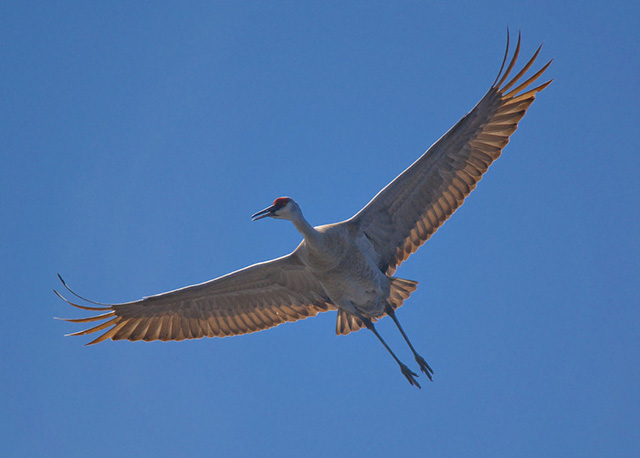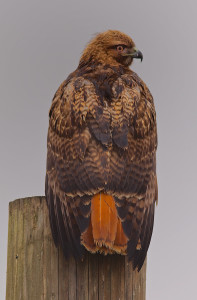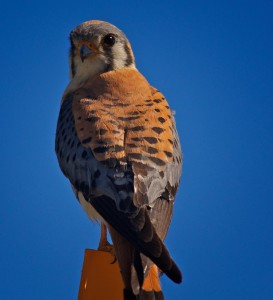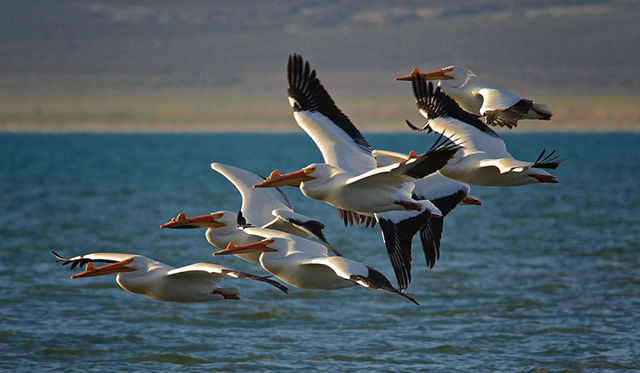
 Sandhill cranes are among more than 300 species of migratory birds that have been killed legally across the US since 2011 to protect a wide range of business activities and public facilities under what’s called the “depredation permit” program. (Photo: Tom Knudson/Reveal)
Sandhill cranes are among more than 300 species of migratory birds that have been killed legally across the US since 2011 to protect a wide range of business activities and public facilities under what’s called the “depredation permit” program. (Photo: Tom Knudson/Reveal)
This story was originally published by Reveal from The Center for Investigative Reporting.
Every spring, bird-watchers from across America gather in Nebraska for one of the continent’s great avian spectacles – the mass migration of sandhill cranes through an hourglass-like passage along the Platte River.
The birds rarely disappoint: With enormous wingspans, they circle like hang gliders over the river valley, filling the air with raucous revelry. And according to fossil records, they’ve been carrying on like that for quite some time: 9 million years, in fact, making them North America’s oldest bird species.
But some several hundred miles northeast in Wisconsin and Michigan, sandhill cranes are met with a different reception: They are shot dead by farmers or their hired guns under a little-known federal program that allows for the killing of birds protected by one of this nation’s bedrock conservation laws, the Migratory Bird Treaty Act of 1918.
 Red-tailed hawks are among the migratory birds that have been killed under the federal “depredation permit” program. (Photo: Tom Knudson/Reveal)What happens to those cranes may seem surprising. But it is not out of the ordinary.
Red-tailed hawks are among the migratory birds that have been killed under the federal “depredation permit” program. (Photo: Tom Knudson/Reveal)What happens to those cranes may seem surprising. But it is not out of the ordinary.
Reveal has obtained never-before-released data from the U.S. Fish and Wildlife Service showing more than 300 species of migratory birds – from red-tailed hawks to American kestrels, turkey vultures to mallard ducks – have been killed legally across the United States since 2011 to protect a wide range of business activities and public facilities under what’s called the “depredation permit” program.
Even in the best of times, migratory birds lead perilous lives. Today, with climate change and habitat loss adding to the danger, wildlife advocates say the government-sanctioned killing is a taxpayer-funded threat that the birds should not have to face, one that is hidden from the public and often puts the needs of commerce ahead of conservation.
The birds are dispatched to protect farm fields, vineyards, air traffic, golf courses, pistachio orchards, landfills, fish farms, zoos and aquariums. Some birds are killed for environmental reasons, such as protecting rare Western snowy plovers.
For their part, most of the sandhill cranes usually were killed for eating farmers’ potatoes and corn.
Most of the species killed are in no biological danger – their populations are stable. But many are beloved by a broad swath of American society, including great blue herons, white and brown pelicans, cedar waxwings, robins, belted kingfishers and mourning doves.
And some are struggling to cope with habitat loss, climate change and other threats and are classified by the government as “birds of conservation concern.” These include upland sandpipers, lesser yellowlegs, roseate spoonbills and red-throated loons, who, because of declining populations, could be on their way to the endangered species list.
Agency policy says killing birds is meant to be a temporary fix. Yet its own data show lethal removal often is the default option. Eighty-nine of the 100 businesses and agencies responsible for the most mortalities received permission from the service to kill the same species of birds at least three years in a row, the permit data show.
Even the service’s top permitting official is concerned. George Allen, head of the migratory bird division’s permits and regulation office, said he’d want to address that issue if he had time to revisit the agency’s rules.
“It’s just not one we’ve worked on,” he said.
The total body count for a recent three-year period came to 1.6 million, including more than 4,600 sandhill cranes. Four populous species – brown-headed cowbirds, red-winged blackbirds, common grackles and Canada geese – accounted for two-thirds of the mortalities.
But many less common birds were killed, too, including 875 upland sandpipers, 479 barn owls, 79 wood ducks, 55 lesser yellowlegs, 46 snowy owls, 12 roseate spoonbills, three curlew sandpipers, two red-throated loons and one western bluebird.
 Most of the birds killed under the federal “depredation permit” program, including great blue herons, have stable populations and aren’t in any biological danger. (Photo: Tom Knudson/Reveal)
Most of the birds killed under the federal “depredation permit” program, including great blue herons, have stable populations and aren’t in any biological danger. (Photo: Tom Knudson/Reveal)
Birds were killed from coast to coast, but certain places were more deadly than others.
The most lethal state was Louisiana, where nearly 600,000 brown-headed cowbirds were killed in part to protect rice farms.
The second deadliest was California, where American coots were killed by the thousands to protect golf course greens and fairways. Usually the birds are shot, but sometimes they’re fed bait laced with a chemical that makes them fall asleep. Then they’re rounded up and killed in portable carbon dioxide chambers in the backs of pickup trucks. In California, some robins also were killed to protect vineyards.
No. 3 was Arkansas, where more than 22,000 double-breasted cormorants and thousands of other fish-eating birds were killed at fish hatcheries and aquaculture facilities.
Most of the killing is carried out without public notice. Even many conservationists are unaware of it. But those who are familiar with the permit program mostly don’t like it. They say that nonlethal options – such as scaring birds away or making the landscape less bird-friendly – are not given enough consideration and that lethal action is too often the default option.
“Nonlethal methods should always be given preference in these kinds of situations,” said Mike Daulton, vice president of government relations for the National Audubon Society, one of the nation’s oldest and most powerful conservation organizations. “The Migratory Bird Treaty Act is one of America’s most important wildlife conservation laws, and it should be strongly and reasonably enforced to maintain healthy wild populations of America’s native birds.”
Allen at the Fish and Wildlife Service said allowing the killing of nuisance birds protected by the Migratory Bird Treaty Act isn’t antithetical to the service’s mission of conserving wildlife populations.
“Promoting populations is good,” he said. “But without offering people an option to control what are obvious problems, we’re not doing our job, either.”
See the data: Birds killed under depredation permits in the United States
Birds and humans have clashed for generations, of course. That’s why farmers put out scarecrows. But as cities and agriculture have grown, the scope of the conflicts has expanded. Today, even green industries sometimes kill birds. The government estimates that wind farms will take the lives of 1 million birds every year by 2030. To make that legal, the Fish and Wildlife Service is considering a new permit system for the “incidental” killing of birds protected by the Migratory Bird Treaty Act.
That act, a cornerstone of U.S. conservation history, grew out of an era of excess and slaughter at the turn of the 20th century. Many of North America’s migratory birds were being decimated, not for food but for feathers and other body parts that were used to make ladies’ hats, which had become signs of luxury and sophistication. In 1916, the United States and Great Britain, on behalf of Canada, signed the Migratory Bird Treaty Act. It became illegal to kill or capture migratory birds, as well as to buy or sell them.
The U.S. government, however, later made an exception. If a migratory bird is causing economic damage (such as destroying crops), posing a risk to humans (airports) or doing some other type of damage, a landowner can ask the Fish and Wildlife Service to approve the “lethal take,” or killing, of the problem birds.
In order to get a permit, applicants must explain what nonlethal measures they’ve tried and why they didn’t work. The idea is to demonstrate that killing the birds is a last resort.
 American kestrels are among the migratory birds that have been killed under the federal “depredation permit” program. (Photo: Tom Knudson/Reveal)The Fish and Wildlife Service generally doesn’t have the capacity to rigorously check what alternative methods each and every applicant has tried. Instead, it farms the work out to another government agency with a similar name but different mission: Wildlife Services, a branch of the U.S. Department of Agriculture.
American kestrels are among the migratory birds that have been killed under the federal “depredation permit” program. (Photo: Tom Knudson/Reveal)The Fish and Wildlife Service generally doesn’t have the capacity to rigorously check what alternative methods each and every applicant has tried. Instead, it farms the work out to another government agency with a similar name but different mission: Wildlife Services, a branch of the U.S. Department of Agriculture.
For generations, Wildlife Services has long specialized in killing wildlife – including migratory birds – that are considered a threat to agriculture, commerce and the public. In recent years, the agency’s practices have drawn volleys of criticism from wildlife advocates and some members of Congress, who say they are scientifically unsound, heavy-handed and inhumane.
The agency relies on traps, snares and poison that kill indiscriminately. In 2012, the Sacramento Bee reported that Wildlife Services had killed more than 50,000 animals by mistake since 2000, including federally protected bald and golden eagles; more than 1,100 dogs, including family pets; and several species considered rare or imperiled. The investigation also noted that a growing body of science has found the agency’s killing of predators “is altering ecosystems in ways that diminish biodiversity, degrade habitat and invite disease.”
The U.S. Department of Agriculture’s Office of Inspector General now is conducting an audit to determine if the agency’s lethal control is justified and effective.
“Wildlife Services depends on killing predators and depredating migratory birds for its existence. When that’s what you do for a living, you tend to encourage people to adopt that solution,” said Daniel Rohlf, an environmental lawyer and professor at Lewis and Clark Law School in Oregon.
When landowners do get a permit to kill birds, Wildlife Services often is contracted to do the work. That contributes to a tendency to look to lethal control, rather than find more creative, nonlethal solutions, Rohlf said.
But many wildlife managers say killing the birds, while controversial, is an important tool in protecting property and human safety.
Stephen Vantassel is a former wildlife management operator who runs the Internet Center for Wildlife Damage Management at the University of Nebraska-Lincoln. People are too quick to “demonize” lethal control, he said. It’s an important element in any wildlife control plan.
Vantassel said that in some cases, killing a few birds in tandem with other methods, such as loud blasts, makes those nonlethal methods more effective since some species will come to associate the noise with death.
But the International Crane Foundation, the world’s largest crane protection organization in Baraboo, Wisconsin, says the deaths just make room for other birds to take their place in prime habitat.
The foundation’s research coordinator, Anne Lacy, was startled to hear that so many sandhill cranes were being killed. “It’s ineffective,” she said. “Shooting two or five or 10 out of a flock – five days later, another group of birds might move through.”
 Most of the birds killed under the federal “depredation permit” program, including white pelicans, have stable populations and aren’t in any biological danger. (Photo: Tom Knudson/Reveal)
Most of the birds killed under the federal “depredation permit” program, including white pelicans, have stable populations and aren’t in any biological danger. (Photo: Tom Knudson/Reveal)
There are alternatives to lethal methods, from reflective tape to pyrotechnics to hanging dead birds in effigy to frighten living ones away. That’s what the Fish and Wildlife Service recommended that The Living Desert, a zoo in Palm Desert, California, do to deal with a raven problem. And it also offered some public relations advice. “It is strongly encouraged that efforts are conducted out-of-view of the public,” the permit says.
In Wisconsin, the crane foundation recommends a corn seed treatment it helped develop called Avipel that irritates the birds’ stomachs so much that they fly off to find other food.
But more and more, people are turning to old-fashioned solutions: dogs and falcons.
Specially trained border collies are hired to race around golf courses, parks and other places to chase away nuisance birds on a regular basis. New York City’s Central Park took on two collies in 2007 to keep geese away. And Portland International Airport, which has one of the lowest rates of intentional bird deaths among major metropolitan airports, also employs a collie, named Fish, to chase geese.
Falconers are hired to fly the predatory birds above vineyards, berry farms and landfills to scare – but not kill – depredating birds. Brad Felger, the president of Airstrike Bird Control, got his start decades ago as a falconry hobbyist who put his birds to use at California’s Central Coast vineyards. Now his team operates at vineyards, farms, landfills and power stations throughout California and the Pacific Northwest.
“It’s starting to be recognized as an extremely effective method,” Felger said. “It uses the predator-prey response to put the small birds into overload. It’s a little too much for them and they just move on.”
This story was edited by Andrew Donohue and copy edited by Sheela Kamath.
Reveal from The Center for Investigative Reporting is a nonprofit news organization based in the San Francisco Bay Area. Subscribe to the Reveal podcast and visit our website to learn more.
4 Days Left: All gifts to Truthout now matched!
From now until the end of the year, all donations to Truthout will be matched dollar for dollar up to $44,000! Thanks to a generous supporter, your one-time gift today will be matched immediately. As well, your monthly donation will be matched for the whole first year, doubling your impact.
We have just 4 days left to raise $44,000 and receive the full match.
This matching gift comes at a critical time. As Trump attempts to silence dissenting voices and oppositional nonprofits, reader support is our best defense against the right-wing agenda.
Help Truthout confront Trump’s fascism in 2026, and have your donation matched now!